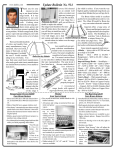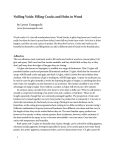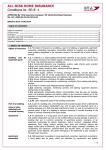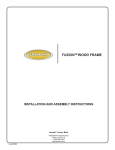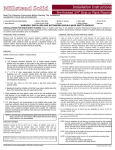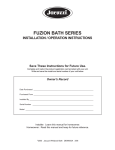Download RANGE HOOD INSTALLATION INSTRUCTIONS
Transcript
RANGE HOOD INSTALLATION INSTRUCTIONS ABBAKA Hoods Using Hy-Ex Remote Ventilators PLEASE READ & SAVE THESE INSTRUCTIONS ALL HOODS MUST BE INSTALLED BY A QUALIFIED INSTALLER OR SERVICE AGENCY WARNING - TO REDUCE RISK OF FIRE, ELECTRIC SHOCK OR INJURY TO PERSON, OBSERVE THE FOLLOWING: A. Installation work and electrical wiring must be done by qualified person(s) in accordance with all applicable codes and standards, including fire-rated construction. Switch power off at service panel and lock the service disconnection means to prevent power from being switched on accidentally during installation. B. When cutting or drilling into wall or ceiling, do not damage electrical wiring and other hidden utilities. C. All hoods must always exhaust to the outdoors. D. Sufficient air is needed for proper combustion and exhausting of gases through the flue (chimney) of fuel burning equipment to prevent back drafting. Local building codes may require the use of make-up air. Consult your local HVAC professional for specific requirements in your area. Follow the heating equipment manufacturer’s guideline and safety standards such as those published by the National Fire Protection Association (NFPA), and the American Society for Heating, Refrigeration and Air Conditioning Engineers (ASHRAE), and state, municipal and local code authorities. The correct voltage, frequency and amperage must be supplied to the appliance from a dedicated, grounded circuit which is protected by a properly sized circuit breaker or time delay fuse. E. Warning - To reduce risk of fire, use only metal ductwork. F. Use this unit in the manner intended by the manufacturer. If you have questions, contact the manufacturer. INSTALLER: Please retain these instructions for reference, then leave them with the homeowner. HOMEOWNER: please read and keep the instructions for future reference. If you have questions concerning the installation of this product, call ABBAKA at (800) 548-3932. www.abbaka.com Tel. (800) 548-3932 - Fax (800) 548-3930 - [email protected] P.O. Box 215, Bodega Bay, CA 94954 Range Hood & Hy-Ex Ventilation System Installation Instructions Contents Warnings ............................................................................................ 1 Unpacking and Planning .................................................................... 3 Pre-Installation Preparation Ducting ......................................................................................... 4-5 Electrical .......................................................................................... 6 Mounting.......................................................................................... 7-8 Liner Re-Install and System Testing .................................................. 9 Care Instructions .............................................................................. 10 Warranty Information........................................................................ 11 www.abbaka.com Tel. (800) 548-3932 - Fax (800) 548-3930 - [email protected] P.O. Box 215, Bodega Bay, CA 94954 Unpacking and Preparation WARNING: HOOD SURFACE SENSITIVE TO SCRATCHING DO NOT LIFT HOOD BY RAILS ABBAKA range hoods consist of the hood shell and a liner, which fits into the base of the hood shell and houses the lighting, filters and controls. 1. After the hood has been uncrated, set it on a flat, padded surface, such as a blanket to protect the hood’s finish. Remove the wrap from the base of the hood and lay the hood down on a long side of the base. 2. Hood Components Note: If hood is fitted with utensil rail, cushion rail before laying on side. Remove Light Panel screws (A). Pop out Light Panel (B) to access screws that attach Duct Light Panel & Liner Removal Hood Stack Typical Island Hood Ceiling Joist Framing Hood Shell C B Liner Light/Switch Control Panel A Light Only Panel liner to interior of hood shell. Remove screws (C) and set the liner aside. PLANNING CONSIDERATIONS In order for the ABBAKA luxury range hood or any hood to operate properly, it must be sized correctly, have adequate blower capacity, be hung properly (centered over cook top and close enough to burners), and be vented correctly. NOTE : The hood should be centered over the cooking surface. NOTE : The recommended mounted height of the hood bottom above the cooking surface is 30-34”. For the Cylindra hood, maximum mounted height is 27” above cooking surface. NOTE : Round stack island hoods will be supplied with a mount bracket. A bracket may be supplied for support of tall hoods. NOTE : When Mounting Island Hoods - Do Not Close Ceiling Before Installation Is Complete. 3 Electrical Knock-Out Ventilator Switch Leg Knock-Out Hy-Ex Professional Exterior Ventilator Correct Ducting and Venting Use proper sized smooth galvanized ductwork- Hy-Ex 1.4 (1400 CFM) 10” round; Hy-Ex 1.0 (1000 CFM) 8” round Do not use flexible duct. Ribbing creates resistance to airflow, reducing exhaust efficiency. Do not space elbows closer than 4’ to each other. Do not make "S" turns or double elbows anywhere in duct run. Do not reduce suggested minimum size anywhere in duct run. Even in wall louvers and roof jacks. (10” round = 78 Sq. In.; 8” round = 51 Sq. In.) Make gradual turns in duct run. Do turn sharp corners. Air cannot make 90° turns. Maximum number of elbows in a duct run is 3. Each elbow is equal to 6’ of duct run. Use the shortest and straightest duct run possible. Maximum duct run is 51’, including elbows. 4 Ducting Hy-Ex Ventilator - Exterior Venting Hy-Ex Remote Ventilator Proper ductwork installation will allow ventilator to efficiently move air from hood to outside the building. Use smooth galvanized ductwork with a minimum number of elbows and bends. All joints must be sealed and run upstream. Ceiling ductwork should “stub down”, cut to length, to mate with backdraft damper of installed liner (see illustration). Ceiling Duct ‘Stub’ From Ceiling Ductwork is not provided with hood. Backdraft Damper Liner Exhaust Outlet Liner Hood Shell NOTES 1. It is recommended to have the range hood on site before determining the terminal position of the duct ‘stub’. Before measuring, attach backdraft damper to exhaust outlet. Use proper size round ducting. 2. In cold climates, insulate the ductwork in cold spaces to prevent moisture condensation in the winter, which can run down the ductwork, into the hood below. A thermal break may be required. Duct Positioning 1000 CFM requires 8” (50 sq. in.) 1400 CFM requires 10” (78 sq. in.) Top View Wall hoods with stack against wall Wall Side Wall hoods with stack centered (Luna and Quantum models) Wall Side 1” Duct Location Duct Location Island Hoods Duct Location Duct centered front to rear 5 Electrical/Liner Installation Hoods Using Hy-Ex Remote Ventilator NOTE: Make all connections in accordance with local codes. Switch power off at service panel and lock the service disconnecting means before wiring the unit. Detailed instructions for electrical connection to the remote ventilator will be packaged with the ventilator. Power cables, connectors, conduit etc. not supplied. Hy-Ex Remote Ventilator Wiring the Hy-Ex Remote Ventilator HYEX-1.4 or 1.O: 1. Run three #14 AWG wires (black, white and green) in conduit from the remote ventilator to the hood. 120VAC 2. Remove ventilator’s top cover. Motor Speed Control 3. Feed conduit through the knock out into the base of the ventilator. Secure with an appropriate connector. Flexible Metal Conduit Duct Hood Stack 4. Connect wires to the terminal block inside the ventilator; connect Black to terminal labeled LINE/ Black, White to NEU/ White terminal and Green to GND/ Ground terminal. Replace ventilator’s cover. 5. Run the 3-wire bundled conduit from the ventilator to the hood. Make the electrical “whip” long enough to reach to the countertop below the installed hood. Hood Shell Liner Liner Knock-out Top View Wiring from Service Panel 1. A 15A circuit is required for installation. It is recommended to dedicate the circuit. 2. Run three #14 AWG wires: (black, white and green) in conduit from service panel to hood. 3. Make the electrical “whip” long enough to reach the countertop below the installed hood. Wiring at the Hood: Refer to Page 9, “Wiring At Hood/Liner Re-Installation & System Test. 6 Supply Knock-Out Ventilator Switch Leg Knock-Out Hanging Wall Mounted Hoods Ceiling 1. Protect the cooktop with a furniture pad or consider building a worktop straddling the counter. Center and square the hood to the actual location of cooktop. Lift in straight line to ceiling and trace outline of stack onto ceiling. Lower hood to rest position. Alternately, use a plumb line and "project" the four corners of the stack to ceiling and mark the position. Wall Stud Upper Wall Attachment Point 2. IMPORTANT: DO NOT LIFT HOOD BY RAILS. 3. With a sheetrock knife, cut opening in ceiling 1/16” larger than previously traced stack outline. Should ceiling not be perfectly level, stack top can be recessed into cut out eliminating possible shadow line. Note: Wall hoods with centered stack (Luna & Quantum models) are supplied with ceiling bracket to position and “plum” stack top. Hood Base Wall Attachment Points 4. NOTE: After installation is completed, any gap between ceiling opening and hood stack can be filled with paint-ready acrylic caulking and painted or framed with molding. Optional decorative ceiling cover plate is offered for difficult to patch wood ceiling. 5. Wall mounted hoods may be attached to the wall at the stud position (see figure above). In some cases, the hood may need to be attached to a plywood backing previously installed in wall behind hood. 6. Drill mount holes through solid back wall of hood cabinet (use cobalt drill bit on stainless hoods) 2" up from base of hood on center with at least two studs. Drill upper attachment hole as close to hood centerline and as high up from hood bottom as possible. 7. Lift hood into position and secure firmly to wall studs or backing with lag bolts and lock nuts. 8. If overall height of hood positions bottom below recommended clearance above cooking surface, excess stack may be cut off. Any ragged cut line or material discoloration from cutting, can be hidden by recessing stack top into sheetrock. NOTE 1: Stainless Steel may be cut in several ways - POWER JIG SAW using carbide blades designed specifically for ferrous or hardened metals (24 teeth per inch), ANGLE GRINDER or heavy duty angle drill using an abrasive type aluminum oxide, diamond edge, or carbide wheel. If using a jigsaw, the cutting process will be slow, generate a lot of heat, and may require several saw blades. "Blueing" or discoloration of the stainless steel may occur during cutting. NOTE 2: When drilling use cobalt drill bits for stainless. Use 1/8" bit for pilot hole and enlarge as needed with "Step-Drill" or progressively larger bits. 7 Hanging Island Hoods Hanging Frame 1. Protect the cooktop with a furniture pad or consider building a worktop straddling the counter. Center and square hood to actual location of cooktop. Leading edge of hood should align with front cooking element, NOT front of cooktop. Using a plumb line, "project" the four corners of the stack to ceiling and mark stack outline. 2. Cut opening in ceiling 2’ - 3’ wider than stack. If there is an attic or crawl space above hood, hanging frame can be built from above. If there is a carpeted room above hood, peel back carpeting and cut access panel through sub-floor to build hanging frame. Build hanging frame with 2 x 4’s . Header off ceiling joists as necessary to frame hood stack. 2 x 4 Frame for Hood Stack Double Header Existing Ceiling Joist 3. Pre-drill stack top with holes for attachment to hanging frame. 6” of stack top should penetrate ceiling line for secure anchorage. 4. Lift hood and slide exhaust stack up into hanging frame. Position hood at desired mount height. Span the island with 2 x 4’s resting on scaffolding, for example, to prop up hood in position. 5. Level hood and temporarily tack in position to hanging frame with sheet rock screws. Firmly attach stack to hanging frame with bolts, lock washers and nuts. If running duct work through joist bay, cut away the side above the ceiling line that will allow an adjustable elbow to turn into the bay. 6. If overall height of hood would position the bottom below recommended clearance above cooking surface, excess stack may be cut off. NOTE 1: Stainless Steel may be cut in several ways - POWER JIG SAW using carbide blades designed specifically for ferrous or hardened metals (24 teeth per inch) ANGLE GRINDER or heavy duty angle drill using an abrasive type aluminum oxide, diamond edge, or carbide wheel. If using a jigsaw, he cutting process will be slow, generate a lot of heat, and may require several saw blades. "Blueing" or discoloration of the stainless steel may occur during cutting. NOTE 2: When drilling use cobalt drill bits for stainless. Use 1/8" bit for pilot hole and enlarge as needed with "Step-Drill" or progressively larger bits. 7. Replace sheetrock. Any gaps around stack can be filled with paint-ready caulking and painted or framed with molding. Optional decorative ceiling cover plate is offered for difficult to patch wood ceiling. 8 Wiring At the Hood: 1. Position hood liner on counter below hood. 2. Remove Light /Switch Control Panel and Light Only Panel (or Screw Covering Panel in wall mount hood) from liner (see Figure A). 3. Feed conduit from ventilator into knock out labeled “Ventilator Switch Leg” and secure with appropriate connector. (Remote or Attic ventilator only). 4. Feed conduit from service panel into knock out labeled “Power Supply” and secure with appropriate connector. 5. Remove filters from liner to simplify mating of transition top to suspended ductwork. Wiring At Hood/Liner Re-Installation & System Testing Typical Island Installation To Ceiling Ductwork Figure A “Switch Leg” to Ventilator Hood Shell A Power Supply from Service Panel B C 6. Lift liner into hood, reaching up through exhaust outlet to transition top, guide liner into place. Re-secure liner with # 8 x ½" Phillips head sheet metal screws. 7. Lift Light Only Panel up to liner and connect black wire to black and white to white. Secure Light Panel to liner wall with screws supplied. (In wall mount hood secure Screw Covering Panel.) 2. Lift bottom edge of liner flush with hood bottom. Guide duct into place and tape inside. vertically 1. Cut section to mate with duct stub from ceiling Light Only Panel Light /Switch Control Panel 8. Lift Light/Switch Control Panel up to liner. 9. Complete “Switch Leg” Connections to Ventilator: black wire from ventilator to the red wire (“Switch Leg”) from motor speed control, white to white, green to green. (Remote or Attic vent only). Do Not connect to service panel power supply. 10. Complete Power Supply Connections. Connect black wire from service panel to black in Light/Control Switch Panel, white to white and green to green. 11. Secure Light/Switch Control Panel to liner wall with screws provided. 12. Tape joint between transition top to round ductwork from inside, running strips of metal foil tape vertically. SYSTEM TESTING 1. Turn on electrical circuit to hood. 2. Switch on ventilator. Rotate variable speed control knob clockwise through full range to see if motor speed is changing accordingly. If motor speed is not changing as knob is rotated, check wiring. NOTE: Motor clicks on at highest speed and runs progressively slower. 3. Switch on halogen lights. If they do not light, check to see that bulbs are securely seated in their sockets. 4. On untreated copper or brass hoods, fingerprints and resulting tarnish or oxidation should be removed with a quality, nonabrasive polish and soft cloth - PLEASE FOLLOW INSTRUCTIONS ON NEXT PAGE. 9 Care Instructions CARE OF YOUR COPPER OR BRASS RANGE HOOD Pure copper or brass, polished to a mirror finish, is used in the fabrication of your ABBAKA Range hood of semiprecious metal. The optional utensil rail and “S” hooks are like wise made of pure mirror- polished brass. These exotic metals are left in their natural state, uncoated, to provide a finished product of the highest luster and natural, rich color. The nature of copper and brass is to tarnish. However, the beauty of these materials is that the brilliance of the original finish can be easily retained with a little care. 1. Do not use harsh alkali (i.e., oven cleaners) or acid base detergents (i.e., acid grout cleaner for tile), abrasive polishes or scouring powders (this is a good rule of thumb for all range hoods regardless of material or finish. Stainless steel or chrome plating can be scratched. The hard surface to enamel finishes will be dulled and become porous). 2. Tarnish can be removed with a number of readily available brass/copper cleaners and polishes. Follow the manufacturer’s directions, using a soft cloth (baby diapers are excellent for this purpose). Polish or wipe in a straight or horizontal direction. DO NOT USE A CIRCULAR MOTION. Use a NON-ABRASIVE POLISH. ABBAKA makes no specific product endorsements. However, products such as WENOL, SIMICHROME, and FLITZ have been found effective. 3. Normal body oils are in part alkali in composition. Consequently, fingerprints will turn to tarnish on copper or brass. After polishing, a light application of wax will retard tarnishing. The wax creates a protective barrier between the metal and tarnish producing moisture or fingerprints. A car wax with silicon, for example, is well suited for the task. 4. Over time, scratching will gradually occur. These fine scratches will eventually work into a smooth, even patina, much in the manner of sterling silver flatware, or an aged brass hand rail or banister. The patina is viewed by many as a desirable trait, and in fact, can add character to the hood. 5. Fine scratches can normally be smoothed or blended into an even patina over the course of time. They can also be completely buffed out by a professional metal refinisher. However, this may require removal and reinstallation of the hood Basic maintenance of your copper or brass ABBAKA range hood will ensure that it retains its natural beauty for generations. Polish with straight level motion, parallel to the bottom of the hood NOTE: Different grain direction on Barrel Forms or hoods with rounded canopy or exhaust flue 10 Care Instructions / Warranty CARE OF YOUR ANTIQUE COPPER OR ANTIQUE BRONZE RANGE HOOD Pure copper or brass is used in the fabrication of your "Antiqued" ABBAKA Range hood. The optional utensil rail and "S" hooks are likewise made of pure brass. These exotic metals are then chemically aged to create a classic distressed look. A matte lacquer top coat is then applied to the antiqued metal's surface to "freeze the aging process". 1. DO NOT USE harsh alkali (i.e., oven cleaners) or acid base detergents (i.e., acid grout cleaner for tile), abrasive polishes, scouring powders or cleaning products containing ammonia, degreasers, strong chemicals or window cleaner products. 2. Use a non-fragranced, mild soap with a neutral pH, like Ivory Liquid detergent, in a 10 to 1 dilution with warm water. Use only soft cotton cloth (old baby diapers softened by many washings are excellent). Soak the cloth in the diluted detergent and wipe in a straight blotting motion. DO NOT USE A CIRCULAR MOTION. DO NOT USE PAPER TOWELS as this wood-based product can scratch and damage the finish. 3. Dry the hood, again, using soft cotton cloth MAINTENANCE OF ENAMELED AND STAINLESS STEEL RANGE HOODS Hoods may be cleaned with any commercially available liquid cleaner. Avoid using cleansers with abrasives, as they may scratch the enamel or stainless steel. Brass utensil rails, if included, may be cleaned with a copper or brass polish (see previous page). Polished stainless steel rails may be cleaned with a soft cloth dampened with a mild soap and water solution, then buffed with a dry clean cloth to restore its luster. NOTE: Always clean and polish with the "grain" of the hood. The "grain" is the series of fine lines in the surface of natural polished metal hoods. It is usually horizontal. Do not clean in a circular motion. ABBAKA LUXURY RANGE HOODS Limited Three (3) Year Warranty ABBAKA warrants the products of its manufacturer to be free from defects in materials and workmanship for a period of three (3) years from date of acquisition by original consumer-owner. Material which proves to be defective after inspection by ABBAKA, will be repaired or replaced at ABBAKA's option. No claims of labor, shipping costs or consequential damages will be accepted. This warranty shall not apply to product which has been altered, used for purposes and conditions other than those for which the product is intended; damaged as a result of shipping, misuse, negligence, accident, faulty installation or maintenance. The warranty covers the hood cabinet, hood liner and motors. The warranty does not cover: A. Freight damage B. Damage caused by faulty installation C. Service charges in your home D. Consequential damage E. Commercial or other misapplication 11











